UV Fused Silica Broadband Plate Beamsplitters (Coating: 400 - 700 nm)
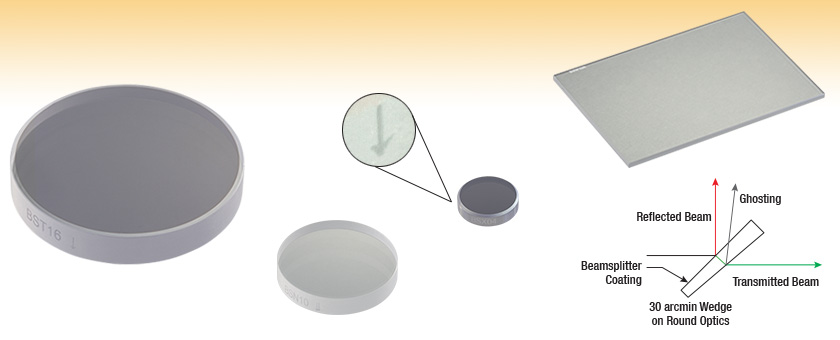
- Beamsplitter Coating for 400 - 700 nm at 45° Incidence
- 10:90, 30:70, 50:50, 70:30, or 90:10 Split Ratios
- Ø1/2", Ø1", 25 mm x 36 mm, and Ø2" Sizes
BST16
Ø2"
BSW10R
25 mm x 36 mm
BSN10
Ø1"
BSX04
Ø1/2"
Engraved Arrow
Points in the Direction
of Light Transmission

Please Wait
| Plate Beamsplitter Selection Guide | |
|---|---|
| Substrate | Beamsplitter Coating |
| UV Fused Silica | 250 - 450 nm |
| 350 - 1100 nm | |
| 400 - 700 nm | |
| 532 nm and 1064 nm | |
| 600 - 1700 nm | |
| 700 - 1100 nm | |
| 1.2 - 1.6 µm | |
| IR Fused Silica | 0.9 - 2.6 µm |
| Calcium Fluoride | 1 - 6 μm |
| 2 - 8 μm | |
| Zinc Selenide | 1 - 12 μm |
| 7 - 14 μm | |
Features
- Beamsplitter Coating on Front Surface: 400 - 700 nm
- Five Split Ratios Available (R:T) Optimized for a 45° Angle of Incidence (AOI)
- 10:90
- 30:70
- 50:50
- 70:30
- 90:10
- Antireflection (AR) Coating on Back Surface: 400 - 700 nm
- Ø1/2", Ø1", 25 mm x 36 mm, and Ø2" Versions Available
- UV Fused Silica Substrate (Transmission Curve; Detailed Substrate Information)
- 30 arcmin Wedged Back Surface on Round Beamsplitters Minimizes Ghosting
Thorlabs' UV Fused Silica Broadband Beamsplitters provide split ratios of 10:90, 30:70, 50:50, 70:30, or 90:10 and have a dielectric beamsplitter coating optimized for the 400 – 700 nm range deposited on the front surface. The dielectric coating is optimized for a 45° angle of incidence and provides long-term stability. These beamsplitters come in Ø1/2", Ø1", 25 mm x 36 mm, and Ø2" sizes.
These plate beamsplitters are fabricated from UV-grade fused silica, which offers high transmission deep into the UV, good homogeneity, and a lower coefficient of thermal expansion than N-BK7. In addition, UV fused silica exhibits virtually no laser-induced fluorescence (as measured at 193 nm), making it an ideal choice for applications from the UV to the near IR.
To help reduce unwanted interference effects (e.g., ghost images) caused by the interaction of light reflected from the front and back surfaces of the optic, all of these plate beamsplitters have an antireflection (AR) coating deposited onto the back surface. This coating is designed for the same operating wavelength range as the beamsplitter coating on the front surface. Approximately 4% of the light incident at 45° on an uncoated substrate will be reflected; by applying an AR coating to the back side of the beamsplitter, this percentage is reduced to an average of less than 1% over the entire operating range of the coating. In addition to this feature, the back of all of our round broadband plate beamsplitters has a 30 arcmin wedge; therefore, the fraction of light that does get reflected from this AR-coated surface will diverge.
The edge of each round plate beamsplitter is engraved with the item number and an arrow pointing to the AR-coated, wedged surface (see the Drawings tab in the blue info icons below for an illustration). Our rectangular beamsplitters, which have been designed for mounting in microscopy filter cubes, feature the engraved item number on the side with the beamsplitter coating, making it easy to differentiate between the front and back surfaces.
Thorlabs offers three types of non-polarizing beamsplitters: Non-polarizing Beamsplitting Cubes (mounted and unmounted), Pellicle Beamsplitters (mounted and unmounted), and the Plate Beamsplitters (see below and selection guide above). For a direct comparison of the performance of our non-polarizing beamsplitting cube, plate, and pellicle at 633 nm, see the Lab Facts tab.
Thorlabs Lab Fact: Beamsplitter Package Matters
We present laboratory measurements of the polarization angle, split ratio, and total throughput power of a beam transmitted through Thorlabs plate, cube, and pellicle beamsplitters. While all non-polarizing beamsplitters function similarly, the exact performance is different for different types of beamsplitter. Each type of beamsplitter contains its own advantages and disadvantages compared to other types of beamsplitters. Appropriate choice of beamsplitter is essential to sensitive experimental systems. We present a complete analysis and comparison of optical parameters for three common types of non-polarizing beamsplitters.
For our experiment we used the former generation HRS015 stabilized HeNe laser (replaced by the HRS015B) as the light source for our investigation. A linear polarizer is used to set the laser beam's polarization axis to 45° in order to provide equal s- and p-polarized light incident on the beamsplitter. The beamsplitter under investigation was then placed in the beampath, and its split beams directed to appropriate detectors. The total power though the optic, polarization states, split ratios, and angle of incidence effects were investigated under this configuration.
The plots below summarize the measured results for all three types of beamsplitters. From these graphs the performance of each optic can be easily compared to one another. The bottom left plot summarizes the results for the total power throughput for each optic. The total power throughput is measured as the fraction of input power. While the plate and pellicle beamsplitters perform rather similarly, the cube shows signs of absorption inside the optic. Additionally, this plot shows the relative insensitivity of throughput power to angle of incidence. The bottom middle graph summarizes the results for the output polarization angle for each optic. The cube shows the most similar polarization angles between the reflected and transmitted beams, with the plate producing the largest difference in polarization between beams. The bottom right plot summarizes the results for the split ratio, as a fraction of input power, for the beamsplitters. Here it can be shown that the plate beamsplitter demonstrates the most ideal for 50/50 power splitting. For details on the experimental setup employed and the results summarized here, please click here.
Beamsplitter Selection Guide
Thorlabs' portfolio contains many different kinds of beamsplitters, which can split beams by intensity or by polarization. We offer plate and cube beamsplitters, though other form factors exist, including pellicle and birefringent crystal. For an overview of the different types and a comparison of their features and applications, please see our overview. Many of our beamsplitters come in premounted or unmounted variants. Below is a complete listing of our beamsplitter offerings. To explore the available types, wavelength ranges, splitting/extinction ratios, transmission, and available sizes for each beamsplitter category, click More [+] in the appropriate row below.Plate Beamsplitters
| Non-Polarizing Plate Beamsplitters |
|---|
| Polarizing Plate Beamsplitters |
|---|
Cube Beamsplitters
| Non-Polarizing Cube Beamsplitters |
|---|
| Polarizing Cube and Polyhedron Beamsplitters |
|---|
Pellicle Beamsplitters
| Non-Polarizing Pellicle Beamsplitters |
|---|
Crystal Beamsplitters
| Polarizing Crystal Beamsplitters |
|---|
Other
| Other Beamsplitters |
|---|
| Damage Threshold Specifications | |
|---|---|
| Coating Designation (Item # Prefix) |
Damage Threshold |
| BSW- | 1 J/cm2 (Ø0.238 mm, 10 ns, 10 Hz, at 532 nm) |
Damage Threshold Data for Thorlabs' 400 - 700 nm AR-Coated 50:50 UV Fused Silica Beamsplitters
The specifications to the right are measured data for Thorlabs' 400 - 700 nm AR-coated UV fused silica beamsplitters. Damage threshold specifications are constant for all 50:50 400 - 700 nm AR-coated UV fused silica beamsplitters.
Laser Induced Damage Threshold Tutorial
The following is a general overview of how laser induced damage thresholds are measured and how the values may be utilized in determining the appropriateness of an optic for a given application. When choosing optics, it is important to understand the Laser Induced Damage Threshold (LIDT) of the optics being used. The LIDT for an optic greatly depends on the type of laser you are using. Continuous wave (CW) lasers typically cause damage from thermal effects (absorption either in the coating or in the substrate). Pulsed lasers, on the other hand, often strip electrons from the lattice structure of an optic before causing thermal damage. Note that the guideline presented here assumes room temperature operation and optics in new condition (i.e., within scratch-dig spec, surface free of contamination, etc.). Because dust or other particles on the surface of an optic can cause damage at lower thresholds, we recommend keeping surfaces clean and free of debris. For more information on cleaning optics, please see our Optics Cleaning tutorial.
Testing Method
Thorlabs' LIDT testing is done in compliance with ISO/DIS 11254 and ISO 21254 specifications.
First, a low-power/energy beam is directed to the optic under test. The optic is exposed in 10 locations to this laser beam for 30 seconds (CW) or for a number of pulses (pulse repetition frequency specified). After exposure, the optic is examined by a microscope (~100X magnification) for any visible damage. The number of locations that are damaged at a particular power/energy level is recorded. Next, the power/energy is either increased or decreased and the optic is exposed at 10 new locations. This process is repeated until damage is observed. The damage threshold is then assigned to be the highest power/energy that the optic can withstand without causing damage. A histogram such as that below represents the testing of one BB1-E02 mirror.

The photograph above is a protected aluminum-coated mirror after LIDT testing. In this particular test, it handled 0.43 J/cm2 (1064 nm, 10 ns pulse, 10 Hz, Ø1.000 mm) before damage.

| Example Test Data | |||
|---|---|---|---|
| Fluence | # of Tested Locations | Locations with Damage | Locations Without Damage |
| 1.50 J/cm2 | 10 | 0 | 10 |
| 1.75 J/cm2 | 10 | 0 | 10 |
| 2.00 J/cm2 | 10 | 0 | 10 |
| 2.25 J/cm2 | 10 | 1 | 9 |
| 3.00 J/cm2 | 10 | 1 | 9 |
| 5.00 J/cm2 | 10 | 9 | 1 |
According to the test, the damage threshold of the mirror was 2.00 J/cm2 (532 nm, 10 ns pulse, 10 Hz, Ø0.803 mm). Please keep in mind that these tests are performed on clean optics, as dirt and contamination can significantly lower the damage threshold of a component. While the test results are only representative of one coating run, Thorlabs specifies damage threshold values that account for coating variances.
Continuous Wave and Long-Pulse Lasers
When an optic is damaged by a continuous wave (CW) laser, it is usually due to the melting of the surface as a result of absorbing the laser's energy or damage to the optical coating (antireflection) [1]. Pulsed lasers with pulse lengths longer than 1 µs can be treated as CW lasers for LIDT discussions.
When pulse lengths are between 1 ns and 1 µs, laser-induced damage can occur either because of absorption or a dielectric breakdown (therefore, a user must check both CW and pulsed LIDT). Absorption is either due to an intrinsic property of the optic or due to surface irregularities; thus LIDT values are only valid for optics meeting or exceeding the surface quality specifications given by a manufacturer. While many optics can handle high power CW lasers, cemented (e.g., achromatic doublets) or highly absorptive (e.g., ND filters) optics tend to have lower CW damage thresholds. These lower thresholds are due to absorption or scattering in the cement or metal coating.

LIDT in linear power density vs. pulse length and spot size. For long pulses to CW, linear power density becomes a constant with spot size. This graph was obtained from [1].

Pulsed lasers with high pulse repetition frequencies (PRF) may behave similarly to CW beams. Unfortunately, this is highly dependent on factors such as absorption and thermal diffusivity, so there is no reliable method for determining when a high PRF laser will damage an optic due to thermal effects. For beams with a high PRF both the average and peak powers must be compared to the equivalent CW power. Additionally, for highly transparent materials, there is little to no drop in the LIDT with increasing PRF.
In order to use the specified CW damage threshold of an optic, it is necessary to know the following:
- Wavelength of your laser
- Beam diameter of your beam (1/e2)
- Approximate intensity profile of your beam (e.g., Gaussian)
- Linear power density of your beam (total power divided by 1/e2 beam diameter)
Thorlabs expresses LIDT for CW lasers as a linear power density measured in W/cm. In this regime, the LIDT given as a linear power density can be applied to any beam diameter; one does not need to compute an adjusted LIDT to adjust for changes in spot size, as demonstrated by the graph to the right. Average linear power density can be calculated using the equation below.

The calculation above assumes a uniform beam intensity profile. You must now consider hotspots in the beam or other non-uniform intensity profiles and roughly calculate a maximum power density. For reference, a Gaussian beam typically has a maximum power density that is twice that of the uniform beam (see lower right).
Now compare the maximum power density to that which is specified as the LIDT for the optic. If the optic was tested at a wavelength other than your operating wavelength, the damage threshold must be scaled appropriately. A good rule of thumb is that the damage threshold has a linear relationship with wavelength such that as you move to shorter wavelengths, the damage threshold decreases (i.e., a LIDT of 10 W/cm at 1310 nm scales to 5 W/cm at 655 nm):

While this rule of thumb provides a general trend, it is not a quantitative analysis of LIDT vs wavelength. In CW applications, for instance, damage scales more strongly with absorption in the coating and substrate, which does not necessarily scale well with wavelength. While the above procedure provides a good rule of thumb for LIDT values, please contact Tech Support if your wavelength is different from the specified LIDT wavelength. If your power density is less than the adjusted LIDT of the optic, then the optic should work for your application.
Please note that we have a buffer built in between the specified damage thresholds online and the tests which we have done, which accommodates variation between batches. Upon request, we can provide individual test information and a testing certificate. The damage analysis will be carried out on a similar optic (customer's optic will not be damaged). Testing may result in additional costs or lead times. Contact Tech Support for more information.
Pulsed Lasers
As previously stated, pulsed lasers typically induce a different type of damage to the optic than CW lasers. Pulsed lasers often do not heat the optic enough to damage it; instead, pulsed lasers produce strong electric fields capable of inducing dielectric breakdown in the material. Unfortunately, it can be very difficult to compare the LIDT specification of an optic to your laser. There are multiple regimes in which a pulsed laser can damage an optic and this is based on the laser's pulse length. The highlighted columns in the table below outline the relevant pulse lengths for our specified LIDT values.
Pulses shorter than 10-9 s cannot be compared to our specified LIDT values with much reliability. In this ultra-short-pulse regime various mechanics, such as multiphoton-avalanche ionization, take over as the predominate damage mechanism [2]. In contrast, pulses between 10-7 s and 10-4 s may cause damage to an optic either because of dielectric breakdown or thermal effects. This means that both CW and pulsed damage thresholds must be compared to the laser beam to determine whether the optic is suitable for your application.
| Pulse Duration | t < 10-9 s | 10-9 < t < 10-7 s | 10-7 < t < 10-4 s | t > 10-4 s |
|---|---|---|---|---|
| Damage Mechanism | Avalanche Ionization | Dielectric Breakdown | Dielectric Breakdown or Thermal | Thermal |
| Relevant Damage Specification | No Comparison (See Above) | Pulsed | Pulsed and CW | CW |
When comparing an LIDT specified for a pulsed laser to your laser, it is essential to know the following:

LIDT in energy density vs. pulse length and spot size. For short pulses, energy density becomes a constant with spot size. This graph was obtained from [1].
- Wavelength of your laser
- Energy density of your beam (total energy divided by 1/e2 area)
- Pulse length of your laser
- Pulse repetition frequency (prf) of your laser
- Beam diameter of your laser (1/e2 )
- Approximate intensity profile of your beam (e.g., Gaussian)
The energy density of your beam should be calculated in terms of J/cm2. The graph to the right shows why expressing the LIDT as an energy density provides the best metric for short pulse sources. In this regime, the LIDT given as an energy density can be applied to any beam diameter; one does not need to compute an adjusted LIDT to adjust for changes in spot size. This calculation assumes a uniform beam intensity profile. You must now adjust this energy density to account for hotspots or other nonuniform intensity profiles and roughly calculate a maximum energy density. For reference a Gaussian beam typically has a maximum energy density that is twice that of the 1/e2 beam.
Now compare the maximum energy density to that which is specified as the LIDT for the optic. If the optic was tested at a wavelength other than your operating wavelength, the damage threshold must be scaled appropriately [3]. A good rule of thumb is that the damage threshold has an inverse square root relationship with wavelength such that as you move to shorter wavelengths, the damage threshold decreases (i.e., a LIDT of 1 J/cm2 at 1064 nm scales to 0.7 J/cm2 at 532 nm):

You now have a wavelength-adjusted energy density, which you will use in the following step.
Beam diameter is also important to know when comparing damage thresholds. While the LIDT, when expressed in units of J/cm², scales independently of spot size; large beam sizes are more likely to illuminate a larger number of defects which can lead to greater variances in the LIDT [4]. For data presented here, a <1 mm beam size was used to measure the LIDT. For beams sizes greater than 5 mm, the LIDT (J/cm2) will not scale independently of beam diameter due to the larger size beam exposing more defects.
The pulse length must now be compensated for. The longer the pulse duration, the more energy the optic can handle. For pulse widths between 1 - 100 ns, an approximation is as follows:

Use this formula to calculate the Adjusted LIDT for an optic based on your pulse length. If your maximum energy density is less than this adjusted LIDT maximum energy density, then the optic should be suitable for your application. Keep in mind that this calculation is only used for pulses between 10-9 s and 10-7 s. For pulses between 10-7 s and 10-4 s, the CW LIDT must also be checked before deeming the optic appropriate for your application.
Please note that we have a buffer built in between the specified damage thresholds online and the tests which we have done, which accommodates variation between batches. Upon request, we can provide individual test information and a testing certificate. Contact Tech Support for more information.
[1] R. M. Wood, Optics and Laser Tech. 29, 517 (1998).
[2] Roger M. Wood, Laser-Induced Damage of Optical Materials (Institute of Physics Publishing, Philadelphia, PA, 2003).
[3] C. W. Carr et al., Phys. Rev. Lett. 91, 127402 (2003).
[4] N. Bloembergen, Appl. Opt. 12, 661 (1973).
| Posted Comments: | |
ILIYA SHOFMAN
(posted 2024-07-10 18:26:10.74) Hello,
I'm interested to know what the transmission and reflection curves are for the BSX10 90R:10T beamsplitter, at normal incidence. Could you please provide me with the curve data for 0-degree AOI?
Also, I wanted to ask if it is possible to apply a Thorlabs -A antireflective coating to the back side of the beamsplitter (i.e., the side opposite to the one with the beamsplitting coating). Could you please provide a cost estimate for this, if such an option is possible?
Thank you,
Iliya Shofman. jdelia
(posted 2024-07-11 12:39:15.0) Thank you for contacting Thorlabs. I have reached out to you directly via email to provide the requested data. The BSX10 does already come with a 400 - 700 nm AR-coating on the back surface. Hyungyu Yu
(posted 2024-04-08 14:18:12.62) Hello, I would like to know the reflectance and transmittance data of the BST 16 and BSW 26 for the wavelength of 200~400 nm. cdolbashian
(posted 2024-04-26 09:31:50.0) Thank you for reaching out to us with this inquiry. The BST16 is only specced within the blue shaded region on the graph (400-700nm) and as such the performance we guarantee will only be valid in this region. The wavelengths which you are inquiring after, 200-400nm, fall outside of the specced region, and thus will not have reliable performance from unit to unit. I have contacted you directly to discuss this and to discuss an alternative. user
(posted 2023-05-08 18:37:35.35) Hello, could you please tell me the effect on R/T ratio when the beam is made to incident on the AR coated side of a plate beam splitter? Thanks! jdelia
(posted 2023-05-23 03:08:15.0) Thank you for contacting Thorlabs. We unfortunately do not have this performance data. You did not leave an email address for us to contact you on this, so if you would like to discuss this further, please reach out to your local Thorlabs technical support team. MY W
(posted 2023-05-04 20:10:33.743) Dear Support team,
I purchased BSS10. I'm very new to optics. I'm wondering if the 30 arcmin wedge angle on the back side of will effect the beam displacement. I'm aligning my optical system, first I try to make sure the light hit on correct height by making the angle of incidence nearly 0degree on to BSS10, if we have parallel surfaces, there should be nearly no refraction and no beam displacement and transmitted light will hit on a calibration mark I made at my desired light. But the transmitted light always deviate from the calibration mark, I'm wondering if it's because the back surface is wedged so light isn't hit perpendicularly onto the back surface?
I also want to know what's the beam displacement equation for this beam splitter. I checked the lateral displacement equation you posted for other comment, but the glass slab in that example has parallel front and back surfaces. I think if our back surface is wedged, then incident angle on the back surface will change and the equation derived will be different and dependent on wedged angle?
Thank you for your time in advance!
Best,
MY jpolaris
(posted 2023-05-17 12:00:29.0) Hello, thank you for contacting Thorlabs. Yes, the 30 arcmin wedge on the back of BSS10 is likely the reason that you are seeing a deviation in beam position. If your angle of incidence is 0°, then there would not be a change in angle of the optical path taking place internal to the optic due to refraction. Rather, the angle of the optical path will change when the beam exits the beamsplitter. This would result in no lateral displacement at the back of the optic. Instead, you will see a lateral displacement later in your optical path. For small angles such as 30 arcmin, the angle the beam exits the backside of BSS10 can be approximated by (n-1)*(30 arcmin), where n is the index of refraction of UVFS at your wavelength. The index of refraction for UVFS is given by its Sellmeier equation located here (https://www.thorlabs.com/newgrouppage9.cfm?objectgroup_id=6973&tabname=uv_fused_Silica). I have reached out to you to discuss this further. Héctor Martínez
(posted 2022-10-17 10:05:33.973) Good afternoon,
I would like to know the maximum power allowed by a BS040 at 461 nm (continuous light).
Laser: 1 W, beam diameter 2 mm, 461 nm.
Does the damage threshold change with the split ratio? Would it be the same for a BS004?
Many thanks in advance,
Héctor cdolbashian
(posted 2022-10-24 09:20:18.0) Thank you for reaching out to us Héctor. While we do not have extensive damage threshold data for all of these splitters, your laser parameters are appropriate such that they shouldn't damage these beam splitters. user
(posted 2022-03-17 18:40:48.337) Hi,
The surface flatness lambda/10 of BSW10 you mention in the pdf file is the flatness of the substrate before coating or the flatness of the final product ? Do you provide RWE value of the final beam splitter? Thanks cdolbashian
(posted 2022-04-01 03:43:32.0) Thank you for reaching out to us at Thorlabs. The flatness is specified for the finished product rather than the bare substrate. The RWE can be found by the simple relationship of RWE ~ surface flatness*2*cos(theta) where theta is the incident angle. At 45 degree incidence, the RWE would be ~ .14*λ (found with the following arithmetic: 2*√(2)/2*λ/10). Aaron Riede
(posted 2020-09-23 12:34:45.67) Hi, can you offer data on the flatness of BSW10R? Something like the maximum angle difference on the reflecting surface? Thanks! YLohia
(posted 2020-09-29 03:38:21.0) Hello, thank you for contacting Thorlabs. Unfortunately, we do not test or specify the surface flatness of the BSW10R. That being said, some of these units have been found to have flatness < 1 wave @ 633 nm. The parallelism of this optic is < 3 arcmin over the clear aperture. Tamar Cromwijk
(posted 2020-09-10 04:31:13.883) Hi,
I want to know the translation of the laser beam (beam shift distance) after the beamsplitter and the maximum angle of incidence. Both for beamsplitter BSN10 and BSW10. YLohia
(posted 2020-09-10 11:40:36.0) Hello, the beam shift will be governed by Snell's Law and the lateral displacement equation (https://brilliant.org/wiki/snells-law/#:~:text=As%20discussed%20earlier%2C%20the%20emergent,ray%20is%20called%20Lateral%20displacement). These beamsplitters are optimized for use at 45 degrees AOI. There is no maximum angle spec since the performance would be characterized as per the user's ability to accept the split ratio performance change as a function of angle. Yoav Romach
(posted 2020-08-24 07:46:02.24) Hey,
What is the CW damage threshold for these beamsplitters?
Can we pass a 1 mm beam of 10W in it?
Thanks,
Yoav YLohia
(posted 2020-08-25 09:22:31.0) Hello Yoav, thank you for contacting Thorlabs. We expect your 1mm diameter 10 Watt CW beam to be fine for the BSN10 in terms of damage threshold. 熙 张
(posted 2020-04-02 16:44:35.137) 请问这款分光镜基板的面形精度是多少? YLohia
(posted 2020-04-02 10:42:28.0) Thank you for contacting Thorlabs. Our Application Engineers from our Tech Support team in China will reach out to you directly. Matthew Majewski
(posted 2020-03-05 23:06:35.643) Hello, I am also interested in the performance of these beamsplitters at 0 degree AOI. Specifically the BSW10 and BSX10 optics nbayconich
(posted 2020-03-09 09:13:34.0) Thank you for contacting Thorlabs. I will reach out to you directly with more information regarding our beamsplitter performance. William Alberto Gómez Guzmán
(posted 2020-02-07 15:36:16.073) Hi, my name is William Gómez. I am physics master student. I would like to ask you about the compensation plate compatible with the beamsppliter https://www.thorlabs.com/thorproduct.cfm?partnumber=BSW16. I was looking for the reference of the plate, but I didn't find it. May you help me with this? or give me a solution? Thanks llamb
(posted 2020-02-12 11:05:23.0) Hello William, thank you for your feedback. When pairing a beamsplitter compensation plate with a beamsplitter, it's ideal to match the substrate materials and thicknesses for best results. While we do not have a Ø2" UVFS compensation plate or window with the same 8 mm thickness as the BSW16, I have reached out to you directly to discuss alternatives for your application. Jim Michels
(posted 2019-10-08 15:58:24.417) I intend to use two BSN10 UV Fused Silica Broadband Plate Beamsplitters (Coating: 400 - 700 nm) with 90:10 split ratios in a self-made Fabry-Perot Interferometer. We already have appropriate Thorlab adjustable and moveable mirror mounts.
Could you please advise regarding the appropriateness of these Beamsplitters for use in the FP interferometer? The intended light source is a Na vapor lamp and the resolution of the two Na D lines.
Thanks,
Jim Michels nbayconich
(posted 2019-10-09 12:48:04.0) Thank you for contacting Thorlabs. I would recommend using the 90:10 R:T BSX10 beamsplitter rather than the 10:90 beamsplitters. The low reflectivity will produce a poor resolution in your fabry perot interferometer system, ideally it's best to use mirrors with a highly reflective coating close to 99% to achieve a high resolution. A 90% reflective mirror can still work in practice however alignment will be critical. We can also offer our dielectric mirrors with AR coating on the back surface which would serve as a better alternative to using a beamsplitter. I will reach out to you directly to discuss your application. matteo.tofanari
(posted 2019-01-18 04:37:50.713) Hi, i intrested in reciving the trasmission data at different angles (e.g. 0, 30, 60, 90) for both polarizations. Thanks YLohia
(posted 2019-02-18 11:18:08.0) Hello, thank you for contacting Thorlabs. I have reached out to you directly with the data. abc124771
(posted 2018-11-14 09:22:40.8) Could you please specify the surface flatness (peak-valley) and surface quality (scratch-dig) for both the front and back surfaces of BSX10? YLohia
(posted 2018-11-14 02:42:04.0) Hello, this information is given on the AutoCAD pdf and the blue "info" icon on the family page. The surface flatness (peak-valley) is λ/10 @ 633 nm over the clear aperture and the surface quality is 20-10 Scratch-Dig. matthieu.guibert
(posted 2018-10-01 17:30:30.443) Hi,
I have the same question than abc124771 : Could you please tell the characteristics (transmittance, reflectance) at 0 deg incidence?
If the answer has been given, could you give it to me please?
Regards,
Matthieu YLohia
(posted 2018-10-02 08:36:56.0) Hello Matthieu, thank you for contacting Thorlabs. The transmission data is available for some of the beamsplitters and can be requested by reaching out to us at techsupport@thorlabs.com. Unfortunately, it is not easy to measure reflectivity at 0 deg AOI. I will reach out to you directly to find out which specific optic you're interested in. user
(posted 2018-08-06 14:07:04.7) These beamsplitters should not be labeled as "broadband" (or beamsplitters) as they do only act as beamsplitters when monochromatic light is used. If more than one color is employed the transmitted and reflected portions are not identical due to the angular dispersion introduced by the "beamsplitter". The 30 arcmin wedge has caused a lot of frustration (and resulted in the loss of many hours) over the years as we are often working with multiple, initially colinear, laser beams or intrinsically broadband LEDs.
Something like beamsplitter with visible AR-coating might stop the less-cautious student from assuming that it is a beamsplitter that can be employed with broadband beams. YLohia
(posted 2018-08-07 08:20:32.0) Thank you for your feedback. By the term "broadband" in this case, we are not referring to the ability of this beamsplitter to be used with a white light source, but the AR coating range. For certain applications, using a broadband source may be fine depending on the requirements of the user. That being said, we recommend looking into our non-polarizing cube beamsplitters for use with broadband sources if you want to maintain colinearity of your laser beams. Please note this would only work for 0 deg AOI, which may require tip/tilt adjustment of the cube. In addition, please review the wavelength-specific performance plots that are provided for each item, which will help to indicate if a particular beamsplitter is appropriate for your light source. abc124771
(posted 2018-05-29 21:30:29.253) Could you please tell the characteristics (transmittance, reflectance) at 0 deg incidence? llamb
(posted 2018-06-06 01:51:24.0) Thank you for contacting Thorlabs. We do indeed have additional transmission and reflection data taken at 0° AOI for some of these beamsplitters. I will reach out to you directly to see which beamsplitters you are specifically interested in. s.o.m.hinterding
(posted 2018-05-18 13:58:30.527) What is the flatness of the plate beam splitters? We are considering using them in our microscopy filter cubes and require flat (radius of curvature > 150 m) beam splitters. If the plates are too curved we will experience astigmatismatic abberations. YLohia
(posted 2018-05-18 05:16:31.0) Hello, thank you for contacting Thorlabs. We do not have any official specification for the 25x36mm parts at the moment due to their thinness, which will work best for transmissive applications (we have a TWE spec for this reason). That being said, we have measured reflected wavefront error (RWE) on the order of several waves for 633nm and we are actively looking into ways of providing this series of parts with better RWE specs. linlinchiayu
(posted 2017-08-09 11:08:01.473) Could you please provide T/R data for wavelengths > 800nm for BSS10R and BST10R? tfrisch
(posted 2017-08-16 09:43:46.0) Hello, thank you for contacting Thorlabs. This data can be found in the raw data link below the graph. I will reach out to you directly as well. martin.theuring
(posted 2017-02-13 04:30:56.507) Could you please provide T/R data for wavelengths > 800nm for BSN10 and BSX10? tfrisch
(posted 2017-02-14 04:22:00.0) Hello, thank you for contacting Thorlabs. I will reach out to you with typical data, though outside the operating band, there will be variations from one lot to another. tnoel2
(posted 2015-05-14 13:06:48.26) Why is it that for some wavelengths the sum of the transmission and reflection is greater than 100%? For example, with the BSW16 between 413 nm and 773 nm, the S-polarized reflectance and transmission sum to more than 100%. I would take this as a result of uncertainty in the measurement, but the sum of relectance and transmission is a slowly varying function of wavelength, so it seems more likely it is a result of some systematic error (e.g. calibration error?). What's going on? besembeson
(posted 2015-07-15 02:32:34.0) Response from Bweh at Thorlabs USA: I checked the data set for the BSW16 and the maximum I have for S-polarization transmission and reflection sum is 99.8% while the maximum for P-polarization sum is 99.59%, which are all under 100%. John.holdsworth
(posted 2014-10-10 12:33:56.693) It is good to offer an AR coated beamsplitter substrate so that you can have a compensation plate in a Michelson that is the same thickness as your beamsplitter. cdaly
(posted 2014-10-11 04:26:43.0) Response from Chris at Thorlabs: The beamsplitter itself is on a 1" diameter, 5mm thick UVFS substrate. We do offer windows with these dimensions, such as the WG41050 (uncoated) and the WG41050-A (AR coated for use at zero degrees AOI). We can also offer one with the beamsplitter AR coating for 45 degrees if needed as a custom. IGKIOU
(posted 2014-01-29 22:22:12.737) Hi,
Do you offer any 3'' diameter versions of these VIS plate beamsplitters? Would such an option perhaps be available as a custom order (a quantity of 3-4 such parts).
Thank you in advance. jlow
(posted 2014-01-30 10:46:31.0) Response from Jeremy at Thorlabs: We can quote custom sizes. I will contact you on the quote. bdada
(posted 2012-01-27 01:58:00.0) Response from Buki at Thorlabs:
We have sent you the BSW16 beamsplitter reflection and transmission data for 10 and 15 degrees AOI. bdada
(posted 2012-01-25 20:17:00.0) Response from Buki at Thorlabs:
Thank you for your feedback. Several customers have expressed interest in T/R curves for various AOI. We are working on this and will send you the data soon. roman_bibo
(posted 2012-01-24 10:20:04.0) Hi,I am also interested in the T/R curves, but for a 10° and 15° angle of incidence. bdada
(posted 2011-09-29 00:06:00.0) Response from Buki at Thorlabs:
We will look into this and contact you directly with more information. matthieu.guibert
(posted 2011-09-27 17:44:21.0) Hi,
Do you know what would be the T/R curves for a 90° angle of incidence? Thorlabs
(posted 2010-11-03 09:40:44.0) Response from Javier at Thorlabs to ar.hassanpour: we currently do not have information regarding laser-induced damage threshold for these beamsplitters. However, they are in the process of getting tested. I will contact you directly once we have data available. ar.hassanpour
(posted 2010-10-26 13:33:43.0) What is the laser-induced damage threshold of such this beamsplitter for a 532nm Nd:YAG laser with a pulse width of 10 ns? |

Click for Raw Data for 300 - 2500 nm
Transmission and reflectance data was obtained for a 45° angle of incidence (AOI). The shaded region denotes the stated beamsplitter coating range. Reflectance and transmission were measured separately using a Perkin Elmer Lambda 950 UV/VIS/NIR spectrophotometer with a calcite polarizer attachment.

Click for Raw Data for 300 - 2500 nm
Transmission and reflectance data was obtained for a 45° angle of incidence (AOI). The shaded region denotes the stated beamsplitter coating range. Reflectance and transmission were measured separately using a Perkin Elmer Lambda 950 UV/VIS/NIR spectrophotometer with a calcite polarizer attachment.

Click for Raw Data for 300 - 2500 nm
Transmission and reflectance data was obtained for a 45° angle of incidence (AOI). The shaded region denotes the stated beamsplitter coating range. Reflectance and transmission were measured separately using a Perkin Elmer Lambda 950 UV/VIS/NIR spectrophotometer with a calcite polarizer attachment.

Click for Raw Data for 300 - 2500 nm
Transmission and reflectance data was obtained for a 45° angle of incidence (AOI). The shaded region denotes the stated beamsplitter coating range. Reflectance and transmission were measured separately using a Perkin Elmer Lambda 950 UV/VIS/NIR spectrophotometer with a calcite polarizer attachment.

Click for Raw Data for 300 - 2500 nm
Transmission and reflectance data was obtained for a 45° angle of incidence (AOI). The shaded region denotes the stated beamsplitter coating range. Reflectance and transmission were measured separately using a Perkin Elmer Lambda 950 UV/VIS/NIR spectrophotometer with a calcite polarizer attachment.
 Products Home
Products Home












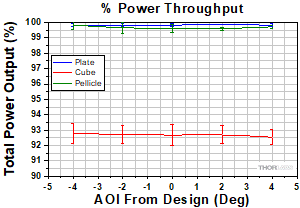
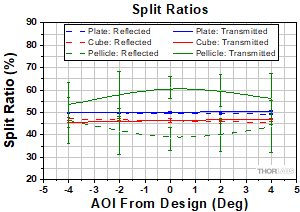
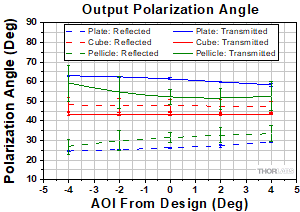

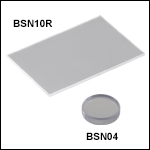
 Zoom
Zoom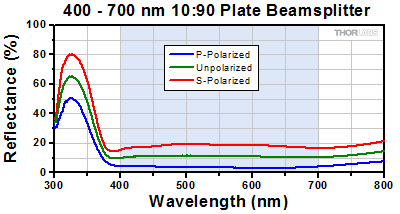
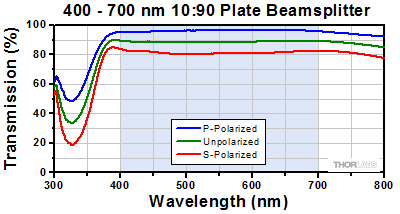
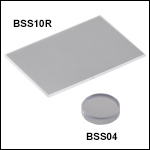
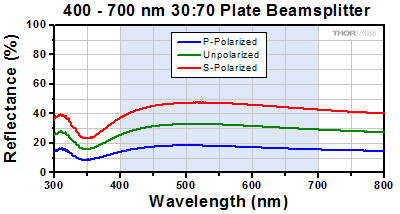
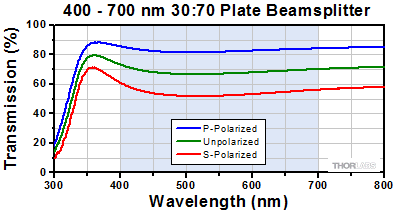
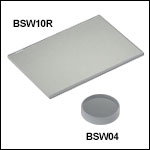
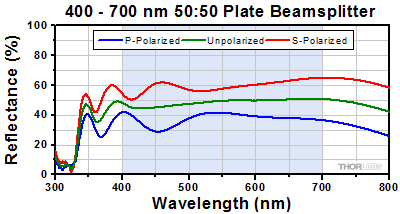
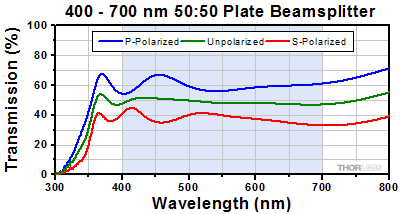
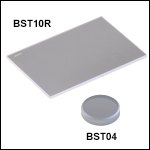
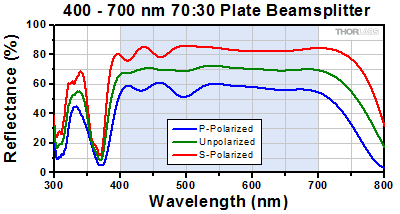
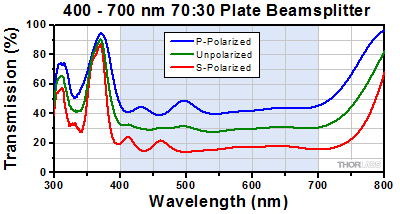
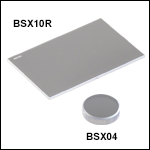
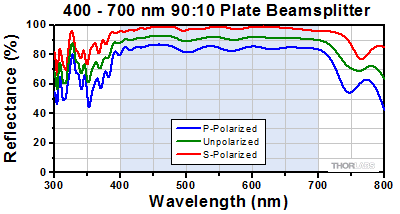
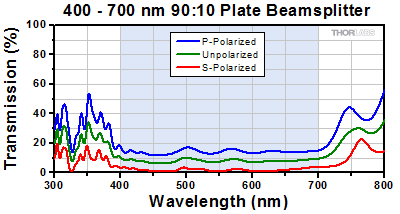
 UV Fused Silica Plate Beamsplitters (Visible)
UV Fused Silica Plate Beamsplitters (Visible)